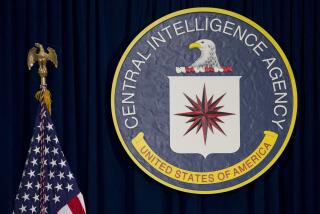CIA has recruited Iranians to defect
WASHINGTON — The CIA launched a secret program in 2005 designed to degrade Iran’s nuclear weapons program by persuading key officials to defect, an effort that has prompted a “handful” of significant departures, current and former U.S. intelligence officials familiar with the operation say.
The previously undisclosed program, which CIA officials dubbed “the Brain Drain,” is part of a major intelligence push against Iran ordered by the White House two years ago.
Intelligence gathered as part of that campaign provided much of the basis for a U.S. report released last week that concluded the Islamic Republic had halted its nuclear weapons work in 2003. Officials declined to say how much of that intelligence could be attributed to the CIA program to recruit defectors.
Although the CIA effort on defections has been aimed in part at gaining information about Tehran’s nuclear capabilities, its goal has been to undermine Iran’s emerging capabilities by plucking key scientists, military officers and other personnel from its nuclear roster.
Encouraging scientists and military officers to defect has been a hallmark of CIA efforts against an array of targets since the height of the Cold War. But officials said those programs did not generally seek to degrade the target’s capabilities, suggesting that U.S. officials believe Iran’s nuclear know-how is still thin enough that it can be depleted.
The program has had limited success. Officials said that fewer than six well-placed Iranians have defected, and that none has been in a position to provide comprehensive information on Tehran’s nuclear program.
The CIA effort reflects the urgency with which the U.S. government has sought to slow down Iran’s nuclear advances, as well as the importance Washington attaches to finding human sources who can help fill intelligence gaps left by high-tech collection methods such as satellites and electronic eavesdropping equipment. The program was described by officials on condition of anonymity because of the sensitivity of the effort.
The White House ordered the stepped-up effort in hopes of gathering stronger evidence that Tehran was making progress toward building a nuclear bomb. The Bush administration “wanted better information” on Iran’s nuclear programs, said a U.S. official briefed on the expanded collection efforts.
“I can’t imagine that they would have ever guessed that the information they got would show that the program was shut down,” the official said.
That was the central finding of the comprehensive intelligence report released last week. The National Intelligence Estimate on Iran contradicted previous intelligence assessments and undercut assertions by the Bush administration.
The new report, which represents the consensus view of all 16 U.S. intelligence agencies, also concluded that Tehran “at a minimum is keeping open the option to develop nuclear weapons” and continuing to pursue civilian nuclear energy technologies that could help it make a bomb.
A CIA spokesman declined to comment on the effort to cultivate defectors, saying “the agency does not comment on these kinds of allegations as a matter of course.”
White House reversal
The administration’s decision to step up intelligence collection on Iran in 2005 was a reversal from a position the White House took after President Bush was first elected. Former CIA officials said that the agency had built up a large Iran Task Force, made up of nearly 100 officers and analysts at headquarters, by the end of the Clinton administration. But that office shrank to fewer than a dozen officers early in the Bush administration, when the White House ordered resources shifted to other targets.
“When Bush came in, they were totally disinterested in Iran,” said a former CIA official who held a senior position at the time. “It went from being a main focus to everything being switched to Iraq.”
Asked about decisions to reduce the size of the Iran Task Force, CIA spokesman Paul Gimigliano said: “Iran has been an issue of priority to the United States for a long time. You shouldn’t assume that a single unit of any size reflects the complete level of effort. That would be a mistake.”
Even as the task force shrank, officials said, other CIA units, including its counter-proliferation division, continued to track Iran’s procurement networks and other targets.
Some of that reduced task force capacity has been restored, former CIA officials said. Two years ago, the agency created an Iran division within its overseas spying operations, applying to a single country resources and emphasis usually reserved for multinational regions.
The stepped-up effort went beyond the CIA, and has also involved the National Security Agency, which eavesdrops on other countries’ communications, and the National Reconnaissance Office, which operates spy satellites.
The defector program was put in place under CIA Director Porter J. Goss, who has since left. The agency compiled a list of dozens of people to target as potential defectors based on a single criterion, according to a former official involved in the operation: “Who, if removed from the program, would have the biggest impact on slowing or stopping their progress?”
The rewards for defectors can be substantial, including relocation to another country and lifetime financial support.
In the two years since it was launched, the program has led to carefully orchestrated extractions of a small group of Iranian officials who operated in the mid- to upper tiers of the Islamic Republic’s nuclear programs.
None of those who defected was considered essential to the nuclear program, nor were they able to provide comprehensive descriptions of Iran’s efforts, officials said.
“Did they have replacements for these people? Any country would have,” the former official involved in the operation said. “But we did slow the program.”
The identities of the defectors have been carefully protected. However, there was speculation this year of CIA involvement in the apparent defection of a former Iranian deputy defense minister, Ali Reza Asgari, who went missing in February during a visit to Turkey.
At the time, Iran’s top police chief was quoted in the official news agency as saying that Asgari probably had been kidnapped by operatives working for Western intelligence services. Asgari was believed to have extensive knowledge of Iran’s conventional weapons program as well as its ties to the militant Shiite Muslim group Hezbollah in Lebanon.
But Asgari was not thought to be involved in Iran’s nuclear program, and the CIA, when pressed by congressional officials about the matter, adamantly denied involvement in the Iranian general’s disappearance.
Officials declined to discuss the whereabouts of the defectors, or details regarding the methods used to approach them. The former senior U.S. intelligence official said that potential defectors had not been approached directly by the CIA, but through other contacts the agency has cultivated inside the country.
Often, the former official said, there are as many as “three degrees of separation” between agency personnel and those targeted for approach, and that each of those interim contacts had to be thoroughly vetted before a planned approach was approved. Those who have left Iran have been debriefed and relocated either by the CIA or with the help of allied intelligence services, the former official said.
The CIA program was implemented after significant debate between the White House and the agency over its size and scope, officials said. National Security Council officials urged the CIA to make the program as broad as possible, and to spread word through Iranian networks that the United States was prepared to help officials leave the country and relocate.
But CIA officials fought to keep the program narrowly targeted to avoid catching the attention of Iran’s intelligence service. Even at that, CIA officials assumed that Iran’s service was keeping close watch on key officials in the nuclear program, and that potential defectors could be decoys.
The “Brain Drain” program is among the latest in a long series of efforts to shore up U.S. intelligence on Iran. It was launched at a time when a presidential commission was preparing a scathing report on the inadequacies of U.S. intelligence on Iran and other nations suspected of having nuclear, chemical or biological weapons.
U.S. intelligence officials said the information that surfaced this summer prompting the reevaluation of Tehran’s nuclear weapons program centered on intercepts of Iranian government officials’ conversations and the seizure of a journal that contained notes documenting the country’s decision to shut down its weapons research.
During a briefing with reporters last week, a senior U.S. intelligence official said that Iran was “the hardest intelligence target there is.”
“I mean, by comparison, North Korea is an open and transparent society,” the official said.
History of setbacks
U.S. intelligence on Iran has been beset by setbacks stretching back more than two decades. The CIA has had no permanent presence in the country since the United States broke diplomatic ties with the country -- and removed embassy personnel, as well as CIA officials who operated under diplomatic cover -- after the 1979 Islamic Revolution.
Afterward, the agency began recruiting sources in Europe and elsewhere, in cities where there are large populations of Iranian expatriates who travel to and from the country. But the effort has been marked by failures.
In 1989, Iran’s intelligence services broke up a network of agents in the country that was being directed by a CIA station in Germany known as “Tefran,” for Tehran-Frankfurt. When that station was shut down, much of the collection work was shifted to Los Angeles, where there is a large population of Iranian immigrants, many of whom visit their home country.
More to Read
Sign up for Essential California
The most important California stories and recommendations in your inbox every morning.
You may occasionally receive promotional content from the Los Angeles Times.










